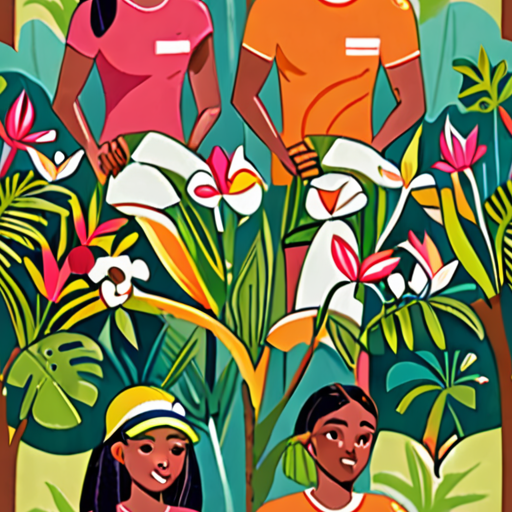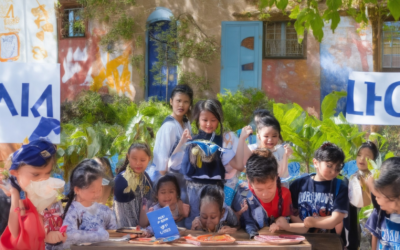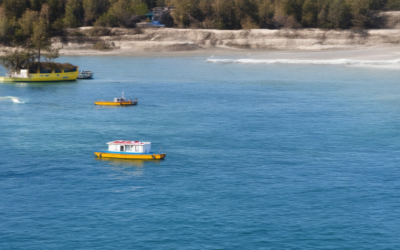Are you looking for a meaningful way to spend your time abroad, immerse yourself in new cultures, and contribute to the well-being of communities in need? Volunteering in Central America can be a life-changing experience that allows you to explore the region’s rich biodiversity, vibrant cities, and warm-hearted people while making a tangible difference in the lives of others.
From teaching English to children in rural Guatemala to assisting conservation efforts in the cloud forests of Costa Rica, there are countless opportunities to get involved and give back to the local communities. Whether you’re a student looking for a unique study-abroad experience, a professional seeking to gain new skills, or simply someone who wants to make a positive impact, volunteering in Central America has something to offer everyone.
In this comprehensive guide, we’ll delve into the ins and outs of volunteering in Central America, covering topics from visa requirements and project options to budgeting and logistics. We’ll also highlight some of the top destinations and organizations offering volunteer opportunities, as well as provide tips and advice for planning a successful and rewarding volunteer trip.
So why wait? Start exploring the many ways you can make a difference in Central America and discover the transformative power of volunteering in this incredible region.

Do You Need a Visa to Volunteer in Central America?
In general, no special visa is required to volunteer abroad in Central America beyond the standard 90-day tourist visa automatically granted to all visitors upon entry into the country.
- The type of visa you’ll need depends on the length and nature of your stay, as well as the specific activities you plan to engage in during your trip.
- For example, if you’re planning to participate in a long-term volunteer program or work remotely, you may need to apply for a different type of visa.
Visa Requirements for Specific Countries in Central America:
- Costa Rica: As a tourist, you can enter Costa Rica without a visa and stay for up to 90 days. However, if you plan to stay longer or engage in certain activities, you may need to apply for a residence visa.
- Panama: Panama offers a “Pensionado” visa program for retirees and digital nomads, which allows you to live and work in the country for up to five years.
- Guatemala: Guatemala requires a tourist visa for stays exceeding 90 days. You can apply for a residence visa if you plan to stay longer or engage in certain activities.
- Nicaragua: Nicaragua has a relatively relaxed visa policy, allowing tourists to stay for up to 90 days without a visa. However, if you plan to stay longer or engage in certain activities, you may need to apply for a residence visa.
- Belize: Belize offers a “Qualified Retired Persons” (QRP) program, which allows retirees and digital nomads to live and work in the country for up to 10 years.
Additional Considerations:
- Before applying for a visa, research the specific requirements for your destination country and ensure you meet the necessary criteria.
- Some countries may require proof of health insurance, financial stability, or a police certificate.
- Additionally, consider consulting with the embassy or consulate of your destination country for the most up-to-date visa information.
Best Practices for Volunteering Abroad:
- Research reputable organizations and programs before committing to a volunteer opportunity.
- Understand the local culture and customs to ensure a respectful and enriching experience.
- Plan ahead and budget accordingly to avoid any last-minute complications.
Where Are Volunteers Most Needed?
I’ve been inspired by various organizations and communities around the world, and I’m excited to share my findings with you.
- The American Red Cross is always looking for volunteers to help with disaster preparedness, blood donations, and supporting our armed forces.
- Inxchan has partnered with several organizations to promote volunteering opportunities, including Habitat for Humanity, which focuses on building affordable housing for those in need.
- Another great organization is the National Park Service, which relies heavily on volunteers to help preserve and protect our nation’s parks and monuments.
When considering where to volunteer, think about the causes that matter most to you and the skills you can bring to the table.
- Research local organizations and charities that align with your values and goals.
- Reach out to these organizations to learn more about their volunteer programs and how you can get involved.
- Consider volunteering abroad through organizations like Inxchan, which offers opportunities to make a difference in communities around the world.
Remember, every hour counts, and even small contributions can make a significant impact.
Some Popular Volunteering Opportunities:
- Habitat for Humanity: Building affordable housing for those in need.
- National Park Service: Preserving and protecting our nation’s parks and monuments.
- American Red Cross: Disaster preparedness, blood donations, and supporting our armed forces.
By volunteering, you’ll not only be making a difference in your community but also gaining valuable skills and experiences that can benefit you in the long run.
Get Involved Today!
Visit the websites of these organizations to learn more about their volunteer programs and how you can get started.
American Red Cross Habitat for Humanity National Park Service Inxchan
Cost of Volunteering in Costa Rica
The cost of volunteering in Costa Rica can vary greatly depending on several factors, including the type of project, duration of stay, and living arrangements.
-
Program Fees:
Many organizations charge program fees ranging from $200 to $1,000 per week, which cover expenses such as accommodation, meals, and project-related activities.
-
Accommodation Costs:
Volunteers typically live with local families or in shared accommodations, with costs ranging from $100 to $300 per month.
-
Food and Transportation:
Food costs can range from $50 to $150 per week, while transportation costs depend on the location and mode of transport, with bus fares starting from $1.
-
Other Expenses:
Additional expenses may include visa fees, vaccinations, and travel insurance, which can range from $50 to $500.
Total estimated costs for a 2-week volunteer trip in Costa Rica can range from $800 to $2,500, depending on individual circumstances.
Some popular volunteer programs in Costa Rica include:
- World Wide Volunteers
- Volunteer HQ
- Go Abroad
When choosing a volunteer program, consider factors such as project alignment, organization reputation, and support services offered.

Where to Volunteer in Latin America
I’ve traveled extensively throughout Latin America, and I can attest that volunteering in this region is a life-changing experience.
-
Costa Rica
Costa Rica offers numerous opportunities to volunteer in conservation efforts, wildlife rescue centers, and community development projects.
- Support reforestation efforts and protect endangered species at the Sea Turtle Conservancy .
- Volunteer at the Costa Rican Wildlife Conservation Center to care for rescued animals.
- Help local communities develop sustainable agriculture practices through the Sustainable Agriculture Network .
-
Peru
Peru provides a unique opportunity to volunteer in the Amazon rainforest, working alongside indigenous communities to preserve their traditional way of life.
- Join the Amazon Rainforest Alliance to support sustainable forest management and conservation efforts.
- Volunteer at the Peruvian Wildlife Conservation Society to protect endangered species and their habitats.
- Assist local communities in developing eco-tourism initiatives through the International Ecotourism Society .
-
Brazil
Brazil offers a diverse range of volunteer opportunities, from working with street children to protecting the Amazon rainforest.
- Volunteer at the Street Children International to support vulnerable youth.
- Join the Amazon Conservation Association to protect the Amazon rainforest and its inhabitants.
- Assist local communities in developing sustainable fishing practices through the World Wildlife Fund .
When choosing a volunteer program, consider factors such as project costs, accommodation options, and the level of support provided by the organization.
Research reputable organizations, read reviews from past volunteers, and ask questions before making a decision.
By volunteering in Latin America, you’ll not only gain valuable skills and experiences but also contribute to meaningful projects that benefit local communities and the environment.
What is the Happiest Country to Live in Latin America?
Costa Rica takes the top spot as the happiest country to live in Latin America, according to the World Happiness Index.
- The country boasts a score of 66 out of 100, indicating a high level of happiness among its citizens.
- This ranking is closely followed by Uruguay and Panama, which also have high scores in the index.
Inxchan travelers often visit Costa Rica for its stunning beaches, lush rainforests, and vibrant culture.
When exploring Costa Rica, consider visiting popular destinations like Arenal Volcano, Monteverde Cloud Forest, and Manuel Antonio National Park.
These locations offer breathtaking scenery, exciting outdoor activities, and opportunities to connect with nature and local communities.
For a deeper understanding of Costa Rica’s unique culture and history, visit the Pre-Columbian Gold Museum in San José or take a guided tour of the city’s historic center.
By immersing yourself in Costa Rica’s natural beauty and rich heritage, you’ll gain a deeper appreciation for what makes this country the happiest place to live in Latin America.
Whether you’re looking for adventure, relaxation, or cultural enrichment, Costa Rica has something for everyone.
As a traveler, you can make a positive impact on local communities by supporting eco-tourism initiatives and responsible tourism practices.
By doing so, you’ll not only enhance your own travel experience but also contribute to the well-being of Costa Rica’s people and environment.
So why wait? Start planning your trip to Costa Rica today and discover why it’s the happiest country to live in Latin America.
Learn more about sustainable travel practices and how to make a positive impact on local communities through our guide to responsible tourism.
Visit our website for more information on traveling responsibly and making a difference in the places you visit.
Discover the beauty and wonder of Costa Rica and experience the joy of living in harmony with nature and local cultures.
Get inspired by our travel stories and tips, and start planning your next adventure today!
Join our community of like-minded travelers and share your experiences and recommendations with us.
Together, let’s explore the world and make a positive impact on the places we visit.
Learn more about Costa Rica’s unique culture and history through our articles and guides.
From delicious cuisine to vibrant festivals, there’s always something new to discover in Costa Rica.
Stay up-to-date with the latest travel news and trends by following our blog.
We’re passionate about sharing our knowledge and expertise with you, so you can have the best possible travel experience.
Thanks for reading, and we look forward to hearing about your travels!

What Country Volunteers the Most?
Sri Lanka holds the title of having the highest number of volunteers worldwide, with approximately 46% of its population participating in volunteering activities.
- The country’s strong culture of community service and social responsibility contributes to its high volunteer rate.
- In addition to individual volunteers, many organizations and businesses in Sri Lanka also engage in corporate social responsibility initiatives, further increasing the overall volunteer count.
Other Countries with High Volunteer Rates
While Sri Lanka takes the lead, several other countries have impressive volunteer rates:
- New Zealand: With around 35% of its population involved in volunteering, New Zealand is a close second.
- Australia: Approximately 30% of Australians participate in volunteering activities, making it a notable contender.
- Iceland: Despite its small population, Iceland boasts a remarkable 28% volunteer rate.
Why Volunteering Matters
Volunteering plays a vital role in fostering community development, promoting social cohesion, and addressing pressing global issues.
- By giving back to society, individuals can develop valuable skills, gain new experiences, and build meaningful connections.
- Volunteering also helps to bridge cultural divides, promote cross-cultural understanding, and support marginalized communities.
Conclusion
In conclusion, Sri Lanka stands out as the country with the highest volunteer rate, followed closely by New Zealand, Australia, and Iceland.
As we continue to navigate the complexities of our world, it is essential to recognize the significance of volunteering and its potential to drive positive change.




0 Comments